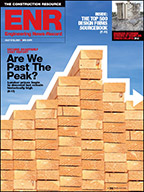COST REPORT: Slim Margins and Uncertainty Making Inflation Dangerous

Construction economists continue to dial back their forecasts for 2011. Single-family housing, public works and the institutional-building markets have all stumbled badly in 2011, says Robert Murray, McGraw-Hill Construction's chief economist. The few bright spots, such as multifamily housing, manufacturing and powerplants, “won't be able to outweigh the minuses,” he says.
Murray estimates that total construction starts in 2011 will come in at $408 billion, a 4% decline from 2010. Since ENR's second quarterly cost report, the forecast for total residential work has been pulled back from a 5% increase to a 2% decline. Likewise, the non-residential market went from a 1% gain to a 3% drop, while the initial 6% drop predicted for non-building work further dimmed to a 7% decline.
“Lack of confidence [see p. 31] and concerns over how Congress is working with the administration are putting people off on making investment decisions,” says Julian Anderson, Phoenix-based president of the cost management firm Rider Levett Bucknall Ltd. “What that is doing to construction costs is scary.” He notes that RLB's selling price index is starting to trend below ENR's Building Cost Index, “and that is something to worry about because it means all the fat has been squeezed out of [bid] pricing,” Anderson adds.
“While there is still a fair amount of work out there, it is less than it was a few years ago, and the competition for it is pretty intense,” says Karl Almstead, Turner vice president responsible for the company's building cost index. Costs will inch up very slowly, but with margins so thin it doesn't take much of an increase to put a project in jeopardy. As a result, Almstead says, there has been growing pressure on subcontractors to pass along some of the higher commodity prices they have been absorbing.
The unsteady overall economy is having an unexpected impact on some construction commodity prices, says Anirban Basu, chief economist for the Associated Builders and Contractors, Arlington, Va. “Some speculative investors are shifting to construction commodities as a hedge against the decline in stock and bonds,” says Basu. “This is causing some prices, such as copper, to increase despite weak construction demand—and that is not good for contractors with slim margins.”
Budget Battles
The winding down of the 2009 American Recovery and Reinvestment Act has caused a contraction in federally funded infrastructure work, but there still are billions of federal dollars in the offing. But the inability of Congress to pass multi-year transportation authorizations and even one-year appropriations for all federal agencies has meant uncertainty over how much construction money will be provided and when it will be available.
Transportation construction companies got a measure of good news when further extensions for surface transportation and aviation programs were signed into law on Sept. 16. The final vote in Congress came on Sept. 15, when the Senate passed the highway-transit and aviation extensions by a 92-6 vote.
Highway and transit programs as well as the motor-fuel tax collections that finance them were extended for six months, through March 31. Aviation programs, including federal airport construction grants, were extended for about four and a half months, through Jan. 31.
Stopgap funding bills have become all too familiar to construction, state transportation and airport authority officials. The new highway-transit extension is the eighth such short-term measure since September 2009; the aviation extension is the 22nd since September 2007. The last multiyear authorizations for those programs expired on those dates.



.jpg?height=200&t=1640194228&width=200)


